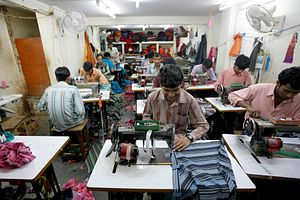Indian Prime Minister Narendra Modi’s maiden Independence Day speech was laced with inspiring rhetoric. But of the many things he said, the one slogan that inevitably caught public attention was this: “Come, make in India!” With those words, Modi was trying to make the case for turning India into the world’s next great manufacturing hub. Understandably, the Indian populace was thrilled.
India is one of the world’s ten largest economies (and is third largest on a purchasing power parity basis), with a total annual output of nearly $2 trillion. As much as 57 percent of this output is produced by a service sector that employs just 28 percent of the population, largely concentrated in urban parts of the country. That is no surprise, because most Indians lack the skills and education to join the more knowledge-intensive service sector. What they need is what successful developing nations all over the world have had ever since the Industrial Revolution: a robust and productive manufacturing sector.
Yet India’s manufacturing sector contributes just 16 percent to the total GDP pie (China’s, by contrast, accounts for almost half of its total economic output). Victor Mallet, writing in the McKinsey book Reimagining India, recently offered an anecdote that was illuminating. “One of India’s largest carmakers recently boasted that it was selling more vehicles than ever and that it was hiring an extra eight hundred workers for its factory,” he wrote, “But the plant employing those workers belongs to the Jaguar Land Rover subsidiary of Tata Motors and is in the English Midlands, not in job-hungry India.”
Mallet goes on to make a point that has been made frequently by Indian economists: The world doesn’t want to “make in India,” because it is simply too painful. There’s bureaucratic red tape, a difficult land acquisition act, troublesome environmental legislation, a shortage of electricity, and a lack of water resources. The only thing India doesn’t seem to lack is labor, but that merely adds to the problem. As Mallet points out in the same essay, aptly titled “Demographic dividend – or disaster?”, “India’s population grew by 181 million in the decade to 2011 – and (despite falling fertility rates) a rise of nearly 50% in the total number of inhabitants is unavoidable.” But the number of jobs being added to feed that population is inadequate.
However, the labor dividend is still important. India doesn’t need to reduce the number of hands on deck. It needs to weed out the challenges that stop them from being productive.
Let’s start with electricity. Almost one-third of the entire Indian population still has no electricity today. That is a whopping 400 million people – more than all of the United States and almost as many as the European Union in its entirety. Much of this has to do with a chronic shortage of coal – a mineral that is responsible for as much as 70 percent of India’s total power output – and losses in transmission. The World Bank estimated that India lost as much as 21 percent of its produced electricity in 2011 through losses in transmission and pilferage – worse than countries like Gabon, Ghana and Senegal for the same year.
Notably, India’s electricity sector is monopolized by state-owned enterprises, both at the central and provincial levels. Private ownership and distribution is difficult and accounts for less than 20 percent of the entire power sector, creating a lack of competition in the market. Renewable energy – a sector most suitable to private production – lacks funding and, like most other sectors, is mired in difficult legislation.
The second great resource needed in abundance for industrial production, but scarce in India, is water. India is a land of rivers, but possesses just 4 percent of the world’s freshwater reserves. Many rivers are mired in dispute, either between nations or between states. The story becomes even more complicated during monsoon season. Few countries have to grapple with both floods and droughts at the same time. Yet, this is common in India. Tropical showers and monsoon winds bring concentrated spells of rain in certain parts of the country, while others are simultaneously mired in drought. Worse, the water that falls during the monsoon is quickly lost, much of it either draining away or causing floods in low-lying areas. If India could find ways to collect and conserve its rainwater, analysts predict that its water shortage might well turn into a surplus.
The good news for Modi is that many of these challenges can be overcome with policy. The recently passed Land Acquisition Act, for instance, applies only to agricultural fields, not the vast tracts of barren land that are untouched in many parts of the country – the northern part of the state of Karnataka, for one. The challenge is to identify these potential “manufacturing zones” and relax laws, supply power, and redirect resources to them. Part of the challenge, as the prime minister has often pointed out himself, lies within the government, not outside. If Modi can streamline the Indian bureaucracy and eliminate some of its excessive discretionary powers, then perhaps “make in India” could become reality.
Mohamed Zeeshan is a student of engineering at VIT University, India and a commentator on issues of Indian and international governance.

































